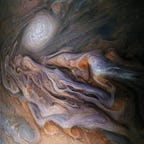Mythology and Our Planets — Part 2
Link to Part 1.
6. Saturn
The planet Saturn is famously adorned with thousands of beautiful rings — fitting, considering the Romans saw Saturn as the god of wealth and plenty.
After the Roman conquest of Greece, Saturn became associated with the Greek Titan Cronus, the Titan of time (whose contributions to the English language span everything from ‘chronic’ to ‘chronology’ and ‘chronicle’.)
The naming of Saturn’s 53 confirmed moons reflects this — its biggest moon is simply called Titan, and others such as Iapetus, Rhea, Hyperion and Atlas are all named after Cronus’ Titan-siblings.
2. Uranus
Most all of the planets so far (with, of course, the notable exception of Earth) have been names for Roman gods and goddesses. Saturn presented an anomaly — a Titan. Uranus presents another.
The planet was named for the powerful Greek primordial deity, Ouranos. Ouranos in Greek mythology was more than just the god of the sky — his body wasthe literal sky, as his consort, Gaia, was the literal Earth. Uranus is also the only planet named for a Greek deity, instead of its Roman counterpart (which in this case is Caelus.)
The planet is an ice giant and a striking sky blue in colour; given this, taking inspiration from Ouranos seems appropriate.
A fascinating coincidence is that the planet was discovered beyond the orbits of Jupiter and Saturn. The coincidence lies in the fact that in Greek/Roman mythology, Ouranos was father to Saturn/Cronus and grandfather to Jupiter/Zeus. The planets, therefore, line up perfectly to give us Jupiter, Saturn, and Uranus — three generations of deity-kings.
7. Neptune
Neptune’s deep brilliant blue colour is unlike that of any other planet’s. It was thus named for the Roman god of the sea. It was later discovered that the planet’s blue colouring comes from methane and not water; rather fittingly, however, over 80% of Neptune’s mass is made of water combined with ammonia and methane.
4. Pluto*
Pluto — Hades to the Greek — was never one of the twelve Olympians, despite being one of the six children of Cronus. When Cronus’ six children overthrew him, the three eldest brothers — Zeus, Poseidon, and Hades — drew lots for dominion over the sky, seas, and underworld. Hades drew the least favoured underworld, and owing to his associations with death and darkness was iced out by his siblings. All went on to become Olympians, were joined over time by six other gods and goddesses, and resided on Mount Olympus in the palace of the gods. Hades lived away from the rest of the gods — in the cold, dark underworld.
Pluto the ice dwarf, in similar fashion, stays in the far outer reaches of the Solar System. So far from the Sun, it is particularly inhospitable — too cold and dark to sustain life. And, of course, in 2006 it was infamously dethroned from planet to dwarf.
The planet’s moons — including Charon, Styx, and Kerberos — are named in keeping with the god’s story. Charon was in mythology the ferryman who ferried the souls of the dead across the River Styx, which represented the boundary between the underworld and the world of the living. Kerberos was the giant three-headed hound dog that guarded the entrance to the underworld.
How romantic to be Pluto: to have been kicked out of Olympus, and then off the list of planets — but to finally have found such enduring love in the hearts of so many. Just ask the collective Internet — Google Pluto and you’ll be told it is “our favourite dwarf planet since 2006”!
* Not technically a planet, granted, but the parallels were too fascinating to overlook.
